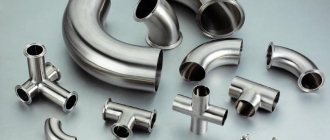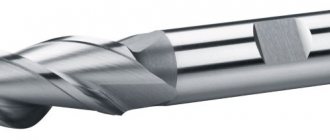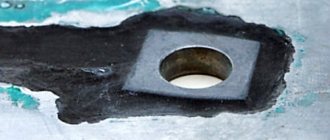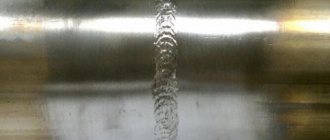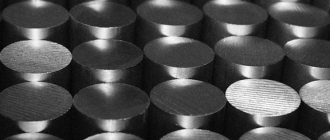09/22/2021 Author: VT-METALL
From this material you will learn:
- Advantages of stainless steel metal products
- Applications of stainless steel
- Types of stainless steel
- Technologies for manufacturing metal products from stainless steel
- Criteria for selecting stainless steel metal products
Stainless steel metal products are widely used in various manufacturing industries. This is explained by its excellent resistance to corrosion and other negative environmental factors. This is achieved due to the iron and carbon contained in this alloy. Thanks to additives, it is possible to regulate the operational and external aesthetic properties of stainless steel products.
Most often, copper, nickel, chromium and manganese are added to the alloy. By adjusting the percentage in the alloy, almost 100% resistance can be achieved even in aggressive environments. That is why stainless steel metal products are used even in medicine and food production. We will talk about other advantages further.
Stainless steel products
Stainless steel products are becoming increasingly popular not only in construction, but also in everyday life. They attract the buyer with their aesthetic appearance and long service life. They are not able to oxidize, are practical to use, and environmentally friendly. The design of structures inside buildings, instruments in the medical industry, products in the chemical and food industries - everything is based on the use of stainless steel.
Benefits of cookware and care
So, stainless steel is safer than other materials. In addition, it is suitable for all cooking surfaces, including induction hobs. Easy to use, does not darken, does not oxidize. The beautiful steel shine fits seamlessly into the modern kitchen design.
The dishes are easy to clean and do not require special care. The only restriction is a ban on abrasive cleaning agents and hard brushes. Their use will certainly leave scratches on the product.
Properties of stainless steel
The physical and technical characteristics of structures made of stainless steel depend on the chromium content. A typical alloy uses up to twenty percent of the element. Due to the fact that the metal combines with oxygen molecules to form an inert protective film, all stainless steel products are famous for their resistance to corrosion.
In addition to the main element chromium, metals such as carbon, manganese, and silicon can be added to the alloy. And to improve its physical properties, factories add nickel, molybdenum, titanium and cobalt to products.
Stainless steel is divided into several types, due to the percentage of metals that are added to it.
- chromium;
- chromium-nickel;
- chrome with the addition of manganese and nickel;
According to its properties, metal is divided into grades:
- 200 series steel. This is the cheapest steel of all series. The AISI 201 brand is the only representative in this series. The alloy contains manganese and nitrogen instead of nickel. Mainly used only in the food industry, in the manufacture of pipes for railings.
- 300 series steel. This series contains four grades of metal. AISI 304, 316 are anti-corrosion and are capable of being in a highly aggressive environment for a long time. Molybdenum is added to the latter grade, which makes it suitable for the oil and textile industries.
- Grades AISI 316 T, 321 are distinguished by the addition of titanium. Moreover, in the last series there is an increased amount of it than in the previous one. This amount of durable metal in the alloy allows it to be used in the production of seamless pipes, gas turbine blades, pipeline fittings, and flanges.
- 400 series stainless steel. This stainless steel has a large amount of chromium in the alloy content. And the low carbon content gives it ductility and good weldability. It is used in the oil and gas industry, for finishing buildings with decorative elements made from this metal. The only brand is AISI 430.
Applications of stainless steel
- Chemical industry. Austenitic stainless steel is used to produce vessels, containers, main pipelines, reactors, etc. A number of areas of the chemical industry require the use of high-alloy steels containing 4–6% molybdenum. When choosing a specific material, the features and technological production cycles are taken into account.
- Food industry. Depending on the type and modification of stainless steel, products are made from it that are used at different stages of food production, starting from the preparation of raw materials for processing and ending with the delivery of products to consumers.
Popular stainless steel products
Due to the fact that objects made of this steel can easily be forged, cut and otherwise given various shapes.
This alloy is used to produce:
- stairs;
- handrails;
- columns, pillars and racks;
- bridges for moving from one platform to another;
The production of stainless steel products also includes the production of:
- sewer pipes;
- pipelines for water supply, heat supply;
- for shipbuilding;
- in medicine for the manufacture of scalpels, tweezers and other medical equipment;
- stainless steel products, which are made from alloys resistant to mechanical damage, decorate buildings, basement entrances, porches;
- it is used in the automotive industry and heavy industry;
Stainless steel pipes are in particular demand. They are quality material. The advantages of stainless steel pipes include strength and reliability. They are not subject to erosion. They can be assembled for both welding and fittings.
Such pipes are polished both outside and inside, which prevents the appearance and proliferation of bacteria.
The only drawback of such pipes is the inability to cut threads yourself.
Methods
Welding of stainless steel structures can be carried out using several methods. We will talk about how to weld stainless steel further.
Manual arc welding with coated electrodes
One of the most common methods is manual arc welding using coated electrodes. The demand for such welding is due to the fact that as a result the performer will receive a high-quality weld. When there are no special requirements for the connection, this method will be the best solution, there is no reason to look for an alternative.
The selection of the electrode is carried out in accordance with the grade of the base metal. The consumable must have an optimal coating composition. There is a wide variety of welding consumables on the market that are used to work with corrosion-resistant steels. The full list is presented here. Welding is most often carried out using direct current of reverse polarity.
Video
The video, without detailed explanations, shows in close-up how the welding process occurs.
https://youtu.be/Zngv3j_zH4g
More information: We also recommend that you read the article on manual welding with coated electrodes of stainless steel.
Tungsten electrodes
For performers who have not yet decided how to cook 1 mm stainless steel, the following method is suitable. Stainless steel welding can also be carried out using tungsten electrodes in a protective gas environment .
This method is used for working with thin metal, when increased reliability requirements are placed on the connection. Also, the seam must meet special conditions.
Tungsten rods are also ideal for welding stainless pipes used for transporting liquids. In this case, the process is carried out in an argon environment, using direct current of direct polarity.
Video
The video clearly shows the process of TIG welding of a pipe.
https://youtu.be/Gq3v2ld5SKU
More detailed information on welding corrosion-resistant steels with various types of rods is presented in the article “Welding stainless steel with electrodes.”
How to weld stainless steel, with the exception of electrodes, will be discussed below. [ads-pc-3][ads-mob-3]
Semi-automatic welding in argon
Semi-automatic argon welding is used to obtain a high-quality connection and achieve high productivity. For this you should use semi-automatic welding machines. Stainless steel wire for this welding method is produced in accordance with GOST standards.
There are several types of wire: universal, alloyed, copper-plated, flux-cored, flux-cored, steel or aluminum.
The welding process begins with preliminary preparation. The contractor needs to set the operating mode of the semi-automatic welding machine: current, voltage and wire feed speed. For metal less than 3 mm thick, the optimal current is from 120 to 145 A. The wire speed is 900 m/h. In this case, direct current of reverse polarity is used.
The work surface should be cleaned, for example with a metal brush.
Then the main stage of work begins. The performer turns on the switch that feeds the wire. Then the arc is ignited. If a melting wire is used, the metal must be touched to initiate the arc. It is necessary to move the burner nozzle exclusively in one direction; there is no need to allow transverse movements. The best option is to weld products at high speed with a single-layer seam.
Video
In the video, a welder who is not entirely confident is welding, but it is quite possible to get an idea of the process.
If a performer has a question: how to cook 2mm stainless steel, then this method will be an excellent option.
Laser
Laser welding of stainless steel is carried out exclusively in industrial conditions, as it requires special equipment. Welding is carried out using spot and seam methods.
Corrosion-resistant steels are laser welded only butt-welded, since the overlap joint creates thermal stresses that negatively affect the overall strength of the product.
The advantages of this method: no reduction in strength in the tempering zone; eliminating the appearance of thermal cracks; The speed and accuracy of the laser beam does not allow the formation of an oxide film. The main feature of the method is faster cooling of the weld.
Plasma
There are manual and automatic plasma welding . Manual welding is carried out using an arc formed between the electrode and the base metal. Another name for the manual method is micro-plasma or mini-plasma. The welding process is performed using alternating current from 0.1 to 15 A. This method is intended for performers who need to weld thin stainless steel. There is also a “beamless nozzle” technique with a voltage of 15-100 A.
The beam flux during automatic welding is produced using a plasma torch. Exposure to alternating current above 100 A and gas flow creates a powerful plasma beam.
Advantages: stability and “rigidity” of the arc allow you to control energy costs; narrow heat-affected zone; fairly accelerated welding rate; the ability to change the distance between the nozzle and the working surface without negatively affecting the quality of the seam. Read more about plasma welding here.
Video
See how you can cook with a small plasma device.
Manufacturing technologies
The production of stainless steel metal products is well established in special steel mills. Products are manufactured by only top-class specialists. Working with this capricious metal requires special training and a high level of skill.
The correct proportions for the structures are set by a special computer program. On the computers used by professional engineers in factories, you can see the finished product side-by-side, in 3D, at the very beginning of the journey, when the order is just being processed by the company’s brain.
Manufacturing of stainless steel structures
Engineering professionals must have creative thinking. Otherwise, the design may turn out to be unattractive and may be rejected by the customer.
Next comes the production process, which is the most complex and time-consuming. The process technology is as follows:
- production of stainless steel itself;
- steel is poured into special molds, where it undergoes a rolling procedure. At this stage, the metal receives special qualities and properties. Without passing this stage, the steel will be considered unprocessed and it will become difficult to work with it;
- then comes stamping and laying out the metal into specially prepared ingots. This type of work is performed not only by qualified workers, but also by specialized machines;
- then it is sanded, painted and delivered ready-made to the customer;
Manufacturing of products to order
Based on the client’s sketches, stainless steel products are produced to order after the design of the future product has been developed. According to individual sizes, specialists can quickly and at an affordable cost produce:
- containers;
- entrance groups;
- awnings;
- fencing;
- racks;
- elements of office and home furniture;
- handrails;
- gratings;
- benches;
- countertops;
- supply and exhaust systems.
Products are manufactured to order from different grades of steel , the choice of which depends on the purpose and operating conditions. For products intended for indoor installation, inexpensive alloy AISI 430 is suitable, which has a pleasant appearance and durability. Rolled metal combines well with plastic, wood, glass and stone.
Interior and exterior items made of stainless steel combine aesthetics, reliability and environmental friendliness. According to the customer's drawings, it is possible to manufacture barbecues, heating and water supply pipes, smokehouses, stair railings, and decorative grates for the fireplace. Austenitic stainless steel is used for storage tanks, mirror frames, car brackets, table tops, vacuum chambers, and shoe stands.
Advantages and disadvantages
The structures made from these alloys are famous for their lifelong service life. Stainless steel has the following advantages over other steel:
- highest resistance to corrosion. To do this, more than seventeen percent chromium is added to the alloy. This ensures the use of structures made from it in any aggressive environment;
- the original appearance and technical properties of the product are preserved even after thirty years of use;
- bacteria never accumulate on such structures;
- heat resistance. Products made from this alloy can be used at high temperatures. They are not deformed;
- Stainless steel structures are famous for their durability.
Types of household smokehouses with a stainless steel water seal
Stainless steel smokehouses have a lot of advantages : light weight, durability, tightness, easy to carry. Such structures are made from sheet metal - stainless steel. In order to prepare stainless steel for use, you need to thoroughly clean it from dirt and dust . If there are dents on thin canvases, they are smoothed out with a hammer.
Photo 1. Homemade smokehouse made of stainless steel. The build quality is no worse than its factory counterparts.
Most owners of factory-made stainless steel smokehouses are dissatisfied with the main disadvantage of the devices - the small thickness of the metal . The miniature size of these products, as well as the thin-walled grilles, are also depressing.
A self-made smokehouse lacks all this. The master has complete freedom to choose both materials and design modifications. must be observed when creating them
Any apparatus for preparing smoked products consists of several main parts:
Secondary elements include doors, control devices, equipment for stacking and hanging products (grids and hooks). A stainless steel smokehouse can be equipped with a water seal, which is otherwise called a water lock.
The purpose of the water seal is to prevent air from penetrating inside the smoking chamber and to prevent smoke and odor from escaping from it. In the first case, the issue of sawdust combustion is resolved, and in the second, the comfort of cooking smoked meats at home is ensured.
A stainless steel smokehouse is always lightweight and portable. It consists of several elements:
- from a sealed metal box with handles (average dimensions 500x300x300 mm );
- from a flat, triangular or semi-oval lid with a soldered hollow tube for smoke removal;
- from a tray on short legs (designed to accumulate fat dripping from food);
- of two gratings arranged in two tiers;
- can be built into the lid .
A firebox and chimney are not provided for this type of smokehouse. Works on the principle of hot smoking. Sawdust and smoking shavings are placed directly on the bottom of the chamber . Smoke is discharged through a hole in the lid. a hose on the tube and take it outside the apartment, for example, through a window.
What you can make from stainless steel with your own hands - Metalworker's Guide
The fastest and most reliable way to fasten metal parts is electric welding.
Anyone can learn how to use it. Having bought a welding machine or an inverter, and also spent half a pack of electrodes to gain practical skills, you can safely try to create metal crafts with your own hands.
Installation of structures, repairs at the dacha, production of garden accessories and much more from now on becomes available.
The first metal crafts
Many people now have welding. Often the device is purchased for construction or repair purposes. Not even necessarily for yourself. If there is a need for it, you can call a self-taught neighbor or a familiar specialist welder. After completion of the work, the unit simply stands idle.
But sooner or later the moment comes when you should make up your mind and try to cook something yourself. There's nothing wrong with that, if you have the desire. The main thing at this stage is not to get burned and not to catch “bunnies”, and experience comes with practice. If you have a summer cottage or a country house, welding will always be used. With its help, you can solve problems of territory development much faster.
Not everything can always be bought in a store. Welding a gate, building a base for a bench or table, “grabbing” a hook to a metal post for attaching a rope or an additional support for weaving grapes - this seems like a small thing, but it seems inconvenient to call a welder over and over again for this reason. This means you need to master the basics and solve everyday problems yourself.
Of course, it’s not worth taking on serious work with critical connections right away. You can practice on a piece of scrap metal. At the first stage, you should learn how to light an arc and hold it, maintaining a constant working gap between the workpiece and the electrode as it burns.
After this, you need to work out the technique of forming a weld, fusing a layer of metal onto a flat surface. Then you can proceed to adjusting the current for different thicknesses of the workpieces being welded.
Welding is a technique for joining two metal parts, based on melting their surfaces at the junction.
They are joined into one by adding a layer of electrode binder material.
The current is selected in such a way as to ensure melting of only the surface layer without the formation of holes. It is better to master the technique on electrodes with a diameter of 2.5-3 mm. They must not be old and must be dry, otherwise the first experience will most likely be ineffective, which may discourage you from learning how to create metal crafts.
Welding makes it possible to correct minor and sometimes serious flaws or installation errors. It is enough to cut off the seam of the “tack”, and the parts are separated. After cleaning the area of unsuccessful welding, the process can be repeated.
Material
Any owner of a country house or owner of a summer cottage will probably have metal waste on their farm. These may be the remains of pipes after the installation of a gas pipeline, water supply or heating systems. A real owner usually does not throw away the remains of a steel angle, channel, or pieces of reinforcement. You can also find used nails, bolts and nuts.
Such scrap metal very often becomes a material for new repairs or improvements to old ones. There will probably be outdated garden tools, chains, old dishes, as well as spare parts from a car, motorcycle or bicycle in the garage or shed that have not yet been handed over to collection points.
From all this you can make useful and practical metal crafts. With your own hands, using welding and available handy tools, you can repair old garden tools or make new ones from waste, taking into account personal experience, your preferences and business conditions.
Metal crafts for the garden
You can make your backyard cozy without purchasing new equipment. From used, but still strong metal, you can build a base for a country table or bench. Finding the right sheet of particleboard for the table top and boards for the bench won't be a problem. Racks can be made even from substandard inch pipes.
If you have a supply of material, you can swing on a swing. It is better to make the structure permanent, with the base concreted. You need two sidewalls made of pipes welded at an angle, with jumpers for rigidity. The more massive the swing seat is, the larger this angle should be. The jumpers can be welded at ground level or even below so that they are not visible.
It is better to make suspensions from chains, but you can also use a reliable rope. The beam for fastening must be massive. A thick-walled pipe, a piece of rail or channel will do. It is best to fasten frame parts and suspension brackets by welding.
Sheet Metal Crafts
At any dacha, with rare exceptions, there is a barbecue or other similar device. A couple of logs for sitting, an old stump as a table and charred bricks for limiting the fireplace and laying skewers - for some, this may be relaxation, but it is better and more convenient to use a more advanced design.
The grill can be disassembled. You can bring it with you to your dacha, or it can also have a permanent home with the possibility of transporting it to a storage location. A barbecue made from an old steel barrel is quite suitable for this solution. You can make it yourself and get by with just a grinder and a drill. However, it will be better and easier if you use a welding machine.
An empty and washed barrel is cut lengthwise along the vertical center line into two halves. Legs made of rods, fittings or pipe sections are welded to one part. The top part serves as a hinged cover and can be mounted for convenience on welded old door curtains.
Crafts made from thin sheet metal can be secured by welding only after gaining some experience. In order to reliably weld parts and not burn a hole with the electrode, you should accurately select the welding current and work with short tacks with constant monitoring of the quality of the seam.
Metal sculpture
The garden around a country house is not only an area where trees and shrubs are grown for collecting fruits and berries. This is also a place to relax! A garden sculpture will be an excellent addition to well-groomed plantings.
It may not necessarily be made of concrete or plaster. For a person with creative potential, there are no limits to its expression. If at the moment you only have at hand a welding machine, half a pack of electrodes, scrap ferrous metal and the desire to create, then from all this you can build an original and unique composition. Moreover, the complexity of execution may vary.
It depends on the available material and the idea. Such metal crafts for the garden in one case can consist of a dozen different, at first glance, incompatible parts of different origins and purposes. In another case, it can consist of hundreds of repeating elements of the same type, connected by welding into a three-dimensional model.
Where do you get ideas?
This question cannot be answered unequivocally. Someone, seeing random details in one place, imagines how they will fit together if they are combined into a common composition. Another purposefully goes to a scrap metal collection point and wanders around mountains of this trash in search of a suitable part for the chosen sculpture.
You can get ideas or simply take someone’s already realized idea as a basis from specialized book publications that are dedicated to metal crafts. There is nothing wrong with creating something you like from scrap materials available around the house.
In any case, DIY metal crafts created according to an existing drawing or sketch will be original. Welding is not copying, but a kind of creativity. Any weld that is made with a decorative intent and repeats a pattern or composition is perceived as a kind of masterpiece.
Safety precautions
To ensure that DIY metal crafts do not serve as a constant reminder of a bad welding experience involving a burn or injury, care should be taken. Working without a mask or shield is strictly prohibited, otherwise you may be exposed to ultraviolet radiation.
https://www.youtube.com/watch?v=wB6pkqM3xrI
A protective suit will protect clothing and body skin from flying sparks and splashes of molten metal, and thick mittens or gloves made of dense material will protect your hands. It is not recommended to knock scale off a seam without protective glasses; sharp fragments flying in all directions can get into your eyes.
When working near wood or fire-prone surfaces, have a bucket of water and a wet cloth on hand. Random sparks or electrode residue that bounce off and land on such materials can cause smoldering and subsequent fire. When working indoors, you need to pay attention to proper ventilation.
Making a smokehouse with your own hands from stainless steel. steel 2 and 3 mm thick. Blueprints
We offer detailed instructions for making a smokehouse made of stainless steel 2 mm thick with the following parameters:
- height 280 mm ;
- length 520 mm ;
- width 310 mm .
Photo 2. Drawing of a stainless steel smokehouse. View in cutting, side and top. You can choose any size of the device.
For work you will need the following materials and tools:
- stainless steel 2 mm ;
- metal corner 15x15 mm ;
- metal rods with a cross-section of at least 2 mm ;
- roulette;
- a simple pencil;
- square;
- angle grinder (grinder);
- metal disc 1-1.5 mm ;
- metal tube with a cross section of 8-10 mm and a length of 2.5-3 cm ;
- wooden block of any section, at least 520 mm .
Photo 3. Drawing of all parts (box, tray, grate) of a stainless steel smokehouse indicating the dimensions of the structure.
All elements of the device are made of the same material . But the handles for the camera and lid can be made from anything non-flammable. These can be fireproof handles from pots or other kitchen utensils.
Project selection
A stainless steel smokehouse can be of any geometric shape : square, rectangular, round. The second form is universal. Suitable for both home and camping conditions.
A round design is chosen if it is necessary to prepare a large number of products in one smoking session. Such devices are in many ways similar to massive tanks. They are difficult to move, so it is recommended to determine a permanent location for the device.
Is this type of cookware safe?
Stainless steel, manufactured without violating technology, is considered the most acceptable. The film on the surface repels bacteria, preventing them from accumulating. The dishes are easy to clean. Stainless steel has the characteristic feature of not interacting with acids, which are abundant in food products. Therefore, dishes made from it are safe. You can both cook and store food, sauces and marinades in it.
There are options to use enamel or aluminum cookware. But we all have known for a long time that you cannot cook foods containing acids in an aluminum pan. Otherwise, iron oxidizes, releasing harmful substances. Enamel is safer, but it also has its disadvantages.
Please note that when purchasing stainless steel kitchen utensils, you should focus on the price. It is better not to buy products that are too cheap. Let's see why? The fact is that cookware made of high-quality steel is expensive, and manufacturers are trying to cheat so that people with wallets of any thickness can buy the product.
True, the cheaper the stainless steel pan, the lighter and more unreliable it will be. Manufacturers make the walls and bottom thinner, and equip such products with handles made of cheap plastic. There are also specific scams when the type of steel does not correspond to what is stated on the label. Then you can give up on the safety of the dishes.
Repairing a stainless steel kettle:
A fairly common occurrence, and a clear example when you need to solder a stainless steel product, is the repair of a stainless steel kettle. And if you have a leak, you shouldn’t throw it away or rush to run for a new kettle. However, it should immediately be noted that stainless steel is very, very poorly soldered, and sometimes it is quite difficult to grab even a small hole (depending on the quality of the stainless steel), but anything is possible.
Kettle made of food grade stainless steel
In order to solder a stainless steel kettle, you will need phosphoric acid or a special flux for soldering stainless steel, food grade tin (it must be safe for the human body! If you need the kettle for drinking water), sandpaper and a 100-watt soldering iron.
All that is needed
First, you need to thoroughly clean the soldering area with sandpaper; if it is a kettle, then you need to remove the scale near the leak.
Cleaning the kettle with sandpaper
And now the fun begins! In order for the solder to “stick” to the stainless steel, you need to warm it up well, but at the same time also treat it with orthophosphoric acid - and it can evaporate, and also leave oxides ingrained in the metal, and again everything will need to be cleaned again . Therefore, the stainless steel itself should not be heated. The secret lies in the soldering iron, or rather, in the soldering iron tip.
As a rule, if you use a soldering iron with a power of one hundred watts with a copper tip, then it overheats very quickly, the solder evaporates, after which scale instantly forms, and soldering is no longer possible (and the heat transfer of the tip drops, because scale conducts heat worse). But there is a way out, use proven, wise advice. First, if your tip is tapered or flattened, shorten it by cutting it straight with a metal saw, leaving about 2-3 centimeters of protruding copper. Then bring the surface of the tip to a copper shine (I used an ordinary fine-grained file for this).
Sharpening the sawn-off tip
Bring the sting to a copper sheen
And then the fun begins, firstly, you need to prepare everything in advance because after heating the soldering iron, you will have to act very quickly and deftly. And that’s why, the temperature of the soldering iron is very high, the tip overheats instantly, and no matter how well you tin it, all the tin evaporates from the surface of the tip quite quickly.
The tin evaporates and the surface of the tip becomes dull
Therefore, do as I did: Apply orthophosphoric acid to the soldering area, rub the tip on a file, tin it, put tin on the tip and do the soldering, and then put tin on the tip again. The thick layer of tin will not have time to evaporate and the tip will not need to be tinned often, but if scale does appear, then rub the tip again on the file until copper appears and quickly tin it. I repeat, everything must be done very quickly, then there will be no scale, and the heat transfer of the soldering iron tip will be sufficient for high-quality heating of the soldering area - which is important!
When soldering stainless steel, the seam may not always turn out aesthetically beautiful. And for greater reliability, it is advisable to completely solder the bottom of the kettle to prevent leakage in another place.
The resulting seam
After you have soldered all the necessary places on the kettle, just for an acceptable appearance, the seam can be polished with sandpaper or a file. After that, be sure to wipe with alcohol to remove any remaining acid, oxides, and scale.
- Plastic rivet, how to use? A rivet is a very common permanent connection. In the most ordinary way.
- Plexiglas bending. How to bend plexiglass? Plexiglas is a fairly common material, often used in many industries.
- DIY applique Many of you have known this simple direction since school.
- A simple and convenient cleaner for the soldering iron tip. Each radio amateur chooses his own special design for the stand.
- Making reusable flexible silicone molds with your own hands There are already quite a lot of ways to create a reusable mold described on the Internet.
What can be made from ferrous metal waste - iron, steel, stainless steel, cast iron
More than 90% of all metal products in the world are made of iron and its alloys.
This trend in industry and active ore mining have caused the depletion of many deposits.
Today, recycling of scrap ferrous metals is gaining momentum.
This was greatly facilitated by the simplified processing process and the low cost of acceptance at metal depots.
It is precisely because of the low cost and high requirements for the delivery of scrap metal that many industrial enterprises refuse to transport scrap to special collection points for ferrous metal. Selling scrap turns out to be unprofitable for the enterprises themselves.
To prevent government watchdogs from imposing penalties for excess iron and steel waste, companies and individuals are attempting to solve the problem themselves .
Types of ferrous scrap
waste includes iron and its various alloys.
Scrap is divided into:
- cast iron (carbon content is more than 2%);
- steel (carbon content less than 2%);
- non-class waste.
In turn, alloys can have alloying elements (aluminum, nickel, molybdenum, etc.) and are divided into:
- carbon;
- alloyed.
According to qualitative indicators, the classification of ferrous metal scrap includes 25 types and 67 groups . You can read more about this in GOST 278-86.
Typical waste options
The most common types of ferrous metal waste :
- Solid pieces of metal of indeterminate shape. It can also be flattened pipes or other hollow products.
- Pipes of various diameters and thicknesses. For devices used in everyday life, they must be cleaned of slag and dirt.
- Automotive scrap: engine parts, wheel axles and other mechanisms.
- Rail metal, including bolts for fastening.
- Steel sheets and perforated scrap. Scraps or substandard metal.
- Hardware products: nuts, bolts, washers and other small scrap metal.
- Steel shavings , including briquetted.
- Steel wire and ropes .
- Oversized cast iron : heating radiators, bathtubs, irons, etc.
- Enameled or galvanized scrap metal: dishes, buckets, etc.
- Details of household electrical appliances .
- Armature.
- Gun parts and ammunition . Dismantled until inoperative. Must not have explosive devices.
- Military equipment. Must be rejected, disassembled and freed from fuels, lubricants and ammunition.
- Various vessels : cylinders, barrels, etc.
- Beds and other parts of industrial equipment.
- Substandard waste: scrap, cast iron slag, furnace slag, waste from manganese production, etc.
Such a variety of black scrap demonstrates the indispensability of iron in our lives.
Profitable sale of ferrous metal
to receive pennies for handing over scrap metal, while spending a lot of time and effort on bringing in old parts. Therefore, owners prefer to store worn-out items in a garage or shed, in the hope that someday it will all gain value.
It is not necessary to accumulate this junk for years, cluttering up useful space. There are quite affordable ways to sell it at a good price and free up space in the utility room.
A cast-iron bathtub, a heavy radiator or a base for a sewing machine - it would seem like rubbish, but someone has been hunting for such things for many years.
You can photograph them and put them up for sale on the appropriate website (Avito, From Hand to Hand, etc.). It will take no more than half an hour.
But there is a chance to get rid of things you don’t need quite quickly.
Selling on the market
There is no need to sit in the market with rusty files or nuts. to hand over this little thing to traders than through scrap metal collection points.
Direct sale
Small private enterprises engaged in figured forging and casting are interested in purchasing high-quality ferrous scrap. If one of these companies is located nearby, you can offer them your metal at a price slightly higher than what they offer at the recycling collection point.
So, scrap ferrous metals:
- gland,
- cast iron,
- become,
- stainless steel
can be taken to recycling collection points. It may be more profitable to sell it online, sell it on the nearest market, or sell it to a company that deals with figured forging and casting.
Household crafts made from ferrous metal
A bad owner is one who does not give a second life to an item that has become obsolete. This is especially true for ferrous metal products. Stainless steel pipes, radiators and containers lying around in landfills may well still serve the purpose.
What can be made from iron waste? Let's list the most common uses of ferrous metal .
Summer shower
This simple but very popular device requires a capacious container a pipe with a tap welded to it .
If you have the parts and a welding machine, the work takes no more than a couple of days, or even less.
An outdoor shower will help you save significantly on hot water during the warm season.
Ground circuit
In the private sector and old houses, they did not think about grounding when they built housing. Nowadays, many household appliances have such high power that they cannot do without grounding.
The grounding device requires 3 thick metal rods 1.5-1.8 meters long and steel rods 1-1.2 meters long .
Small diameter pipes stripped of paint remnants of rails, and metal profiles are suitable as rods . Instead of rods, you can take used reinforcement .
You will also need insulated wire, a welding machine and a pair of working hands for digging a pit.
Although a grounding device is not such a simple thing, it will forever protect your household from electrical discharge.
Watering in the garden and vegetable garden
Large barrels can accumulate precipitation. A drain attached to them from below will help use rainwater as an additional source for irrigation .
It is convenient if your summer cottage does not have its own well, or it is a long walk to a water source.
Press
The most common way to use a small but irregular piece of iron .
Many housewives use a press squeezing cottage cheese or juice
Sufficiently skillful hands are capable of constructing a convenient device from iron and available parts that replaces a juicer .
Brazier
Scraps of sheet metal or substandard material are quite suitable for this device. A mesh placed on top will help you cook not only barbecue, but also barbecued meat or fish.
A real man must have a grill at home in order to please his guests with a meat dish for the May holidays.
The frame from an old washing machine and the remains of a metal profile can be an excellent home for your pet. In such a booth he will not be afraid of strong winds, and it can be insulated from the inside against frost.
Potbelly stove
Although the old stove has long outlived its usefulness, in an open space this type of heating is more effective than lighting a regular fire. Suitable for shepherds or people of other professions who constantly work outdoors.
As you can see, many useful things in everyday life can be made from metal scraps. All you need for this is desire and skillful hands.
Designer products
On city streets you can see original installations made from ferrous metal waste.
Various animal sculptures, frames for flower beds or other crafts fit organically into the urban landscape.
There are also more original products of folk craftsmen.
Small souvenirs made from scrap ferrous metals are suitable both for gifts and as exclusive items.
Different directions are used as ideas.
Military theme
Inlaid flasks, handles made from shells, and tank models will be an excellent addition to congratulations on Defender's Day.
Camping equipment
Homemade
- mugs,
- knives,
- spoons,
- openers
simply irreplaceable for dinner near the fire.
Decorations on the shelf
Beautiful little things sometimes resemble Lefty's products with their sophistication and grace.
Writing instruments
Such unique ferrous metal crafts as:
- stand for stationery,
- pens,
- ashtrays and other accessories.
Fishing gear
Do-it-yourself spinners and weights,
For more information about making crafts from ferrous metal waste, watch the video:
conclusions
If you have imagination and desire, you can make something original and pleasing to the soul out of any thing. A new interpretation of the parable about the puddle comes to mind.
We can say that some people see trash in a pile of scrap metal , while others see a magnificent art sculpture.

